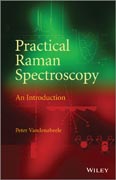
This text offers an open–learning approach to Raman spectroscopy providing detail on instrumentation, applications and discussions questions throughout the book. It provides a valuable guide to assist with teaching Raman spectroscopy which is gaining attention in (analytical) chemistry, and as a consequence, teaching programs have followed. Today, education in Raman spectroscopy is often limited to theoretical aspects (e.g. selection rules), but practical aspects are usually disregarded. With these course notes, the author hopes to fill this gap and include information about Raman instrumentation and how it is interpreted. Provides a user–friendly text that tackles the theoretical background, and offers everyday tips for common practice Raman instrumentation and practical aspects, which are sometimes overlooked, are covered Appropriate for students, and includes summaries, text boxes, illustrating the ideas with examples from research literature or providing background information or links with other courses Written with an open–learning approach, this book will be ideal for use as a self–study guide or as the basis of a taught course with discussion and self–assessment questions throughout the text Includes a comprehensive bibliography to guide the reader to more specialized texts and sources. INDICE: Preface xi Acknowledgements xiii Acronyms, Abbreviations and Symbols xv About the Author xvii Introduction to Raman spectroscopy xix 1 Theoretical Aspects 1 1.1 Classical Approach 1 1.2 Selection Rule 7 1.3 Energy Levels and Group Frequencies 13 1.4 Raman Intensity 19 1.5 Raman Bandwidth 35 1.6 The General Appearance of a Raman Spectrum 37 1.7 Summary 38 Intermezzo 1.1 The Harmonic Oscillator and the Position of the Vibrational Energy Levels 6 Intermezzo 1.2 The Anharmonic Oscillator and the Position of Vibrational Energy Levels 11 Intermezzo 1.3 Raman Intensity Annotations 30 2 Interferences and Side–effects 39 2.1 Absorption 40 2.2 Fluorescence 40 2.3 Thermal Effects, Photodecomposition and Laser Ablation 43 2.4 Ambient Light and Background Radiation 44 2.5 Summary 44 3 Enhancement of the Raman Signal 47 3.1 Resonance Raman (RR) Spectroscopy 48 3.2 Surface–Enhanced Raman Spectroscopy (SERS) 48 3.3 Summary 59 Intermezzo 3.1 The Analysis of Organic Dyes by SERS 58 4 Raman Instrumentation 61 4.1 Lasers 62 4.2 Detectors 74 4.3 Filters 81 4.4 Dispersion Systems 83 4.5 Components for Transportation of Light 88 4.6 Sample Chambers and Measurement Probes 91 4.7 Noise in Raman Spectroscopy 95 4.8 Summary 99 5 Raman Spectroscopy in Daily Lab–life 101 5.1 Calibration of a Raman Spectrometer 102 5.2 Raman Spectral Post–processing 108 5.3 Interpretation of Raman Spectra of Organic Molecules 116 5.4 Interpretation of Raman Spectra of Inorganic Molecules 131 5.5 Quantitative Aspects of Raman Spectroscopy 134 5.6 Fingerprinting and Spectral Searching Algorithms 137 5.7 Raman Mapping and Imaging 141 5.8 Combination with Other Techniques 145 5.9 Summary 147 Intermezzo 5.1 Micro–Raman Spectroscopy in Microbiology 107 Intermezzo 5.2 Raman Spectroscopy in a Forensics Laboratory 117 Intermezzo 5.3 Pigment Analysis with Raman Spectroscopy 132 Intermezzo 5.4 Detection of Counterfeit Medicines with Raman Spectroscopy 136 Intermezzo 5.5 Exobiology: Raman Spectroscopy Helps the Search for Life on Mars 139 Intermezzo 5.6 Direct Analysis of Precious Art Objects 144 Responses to Questions 149 Bibliography 153 Glossary of Terms 155 SI Units and Physical Constants 157 Periodic Table 163 Index 165
- ISBN: 978-0-470-68318-7
- Editorial: Wiley–Blackwell
- Encuadernacion: Rústica
- Páginas: 192
- Fecha Publicación: 16/08/2013
- Nº Volúmenes: 1
- Idioma: Inglés
